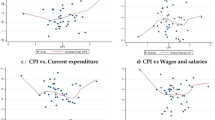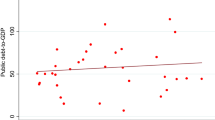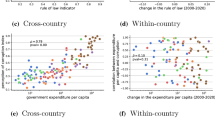Abstract
This paper empirically examines the impact of corruption on the structure of government spending by sector. Using the three-stage least squares method on 64 countries between 1996 and 2001, we show that public corruption distorts the structure of public spending by reducing the portion of social expenditure (education, health and social protection) and increasing the part dedicated to public services and order, fuel and energy, culture, and defense. However, civil and political rights seem to be a stronger determinant of expense on defense than corruption. Our results are robust to instrumentation by the latitude of the country.
Similar content being viewed by others
References
Abed, G.T. and H.R. Davoodi. 2002. “Corruption, Structural Reforms, and Economic Performance in the Transition Economies.” inGovernance, Corruption and Economic Performance. Washington, DC: IMF.
Ablo, E. and R. Reinika. 1998. “Do Budgets Really Matter? Evidence from Public Spending on Education and Health in Uganda.”World Bank Policy Research Working Paper No. 1926
Acemoglu, D., S. Johnson, and J.A. Robinson. 2001. “The Colonial Origins of Comparative Development: An Empirical Investigation.”American Economic Review 91: 1369–1401.
Ehrlich, I. and F.T. Lui. 1999. “Bureaucratic Corruption and Endogenous Economic Growth.”Journal of Political Economy 107: 270–293.
Engerman, S.L. and K.L. Sokoloff. 1997. “Factor Endowments, Institutions, and Differential Paths of Growth among New World Economies: A View from Economic Historians of the United States.” inHow Latin America Fell Behind, edited by Stephen Haber. Stanford: Stanford University Press.
Gupta, S., M. Verhoeven, and E. Tiongson. 2003. “Public Spending on Health Care and the Poor.”Health Economics, 12: 685–696
Gupta, S., H.R. Davoodi, and R. Alonso-Terme. 2002. “Does Corruption Affect Income Inequality and the Poor?”Economics of Governance 3: 23–45.
Gupta, S., L. de Mello, and R. Sharan. 2001. “Corruption and Military Spending.”European Journal of Political Economy 17: 749–777.
Gupta, S., H. Davoodi, and E. Tiongson. 2000. “Corruption and the Provision of Health Care and Education Services.”IMF Working Paper 00/116.
Hall, R.E. and C.I. Jones. 1999. “Why Do Some Countries Produce So Much More Output Per Worker than Others?”quarterly Journal of Economics 114: 83–116.
Hellman, J.S., G. Jones, and D. Kaufmann. 2000. “Seize the State, Seize the Day: State Capture, Corruption and Influence in Transition.”World Bank Policy Research Working Paper 2444.
International Federation for Human Rights. 2005. “Serbia: Discrimination and Corruption, the Flaws in the Health System.”Mission Internationale d'Enquête.
Johnson, S., D. Kaufmann, and P. Zoido-Lobatón. 1999. “Corruption, Public Finances and the Unofficial Economy.”World Bank Policy Research Paper 2169.
Kaufmann, D., A. Kraay, and M. Mastruzzi. 2003. “Governance Matters III: Governance Indicators for 1996–2002.”World Bank Policy Research Working Paper 3106.
Lambsdorff, J.G. 2002. “Corruption and Rent-seeking.”Public Choice 113: 97–125.
Lopes, P.S. 2002. “A Comparative Analysis of Government Social Spending Indicators and Their Correlation with Social Outcomes in Sub-Saharan Africa.”IMF Working Paper 02/176.
Mauro, P. 1995. “Corruption and Growth.”Quarterly Journal of Economics 110: 681–713
Mauro, P. 1997. “The Effects of Corruption on Growth, Investment and Government Expenditure: A Cross-Country Analysis.” inCorruption and the World Economy, edited by K.A. Elliot. Washington, DC: Institute for International Economics.
Mauro, P. 1998. “Corruption and the Composition of Government Expenditure.”Journal of Public Economics 69: 263–279.
Rajkumar, A.S. and V. Swaroop. 2002. “Public Spending and Outcomes: Does Governance Matter?”,Development Research Group—The World Bank.
Reinika, R. and J. Svensson. 2004. “The Power of Information: Evidence from Public Expenditure Tracking Surveys”Global Corruption Report 2004, Transparency International
Shleifer, A. and R.W. Vishny. 1993. “Corruption.”Quarterly Journal of Economics 108: 599–618.
Tanzi, V. 1998. “Corruption Around the World: Causes, Consequences, Scope and Cures.”IMF Staff Papers 45: 559–594.
Tanzi, V. and H. Davoodi. 1997. “Corruption, Public Investment and Growth.”IMF Working Paper 97/139.
Varoudakis, A. 1996. “Régimes non Démocratiques et Croissance, Théorie et Estimation.”Revue Economique 3: 831–840.
Zellner, A. and H. Theil. 1962. “Three Stage Least Squares: Simultaneous Estimation of Simultaneous Equations.”Econometrica 30: 63–68.
Author information
Authors and Affiliations
Corresponding author
Additional information
I am very grateful to Thomas Bossuroy, Julie Lochard, Boris Najman, Waldemar Karpa, Pramuan Bunkanwanicha and the participants of the workshop on corruption at the Sixth Mediterranean Social and Political Research Meeting for their useful comments.
Rights and permissions
About this article
Cite this article
Delavallade, C. Corruption and distribution of public spending in developing countries. J Econ Finan 30, 222–239 (2006). https://doi.org/10.1007/BF02761488
Issue Date:
DOI: https://doi.org/10.1007/BF02761488




